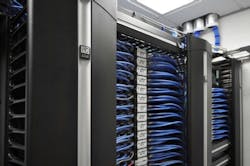In this week’s Voices of the Industry Luca Rozzoni, Senior Product Manager for Europe – Chatsworth Products explains the importance of the three phase PDU for hyper scale data centers.
Luca Rozzoni, Senior Product Manager for Europe – Chatsworth Products
Today’s data centers are seeing a fast growth in power consumption, driven by server machines that are constantly undergoing consolidation and virtualization. This trend started a few years ago and is set to stay for much longer. A large contributor to this trend is the Internet of Things (IoT), which is pushing IT boundaries even further than was ever imagined. The IoT is creating a strong demand for more computing and storage capabilities.
Looking back a few years ago, it was possible to fit 10 of the most power-hungry servers into a single IT rack and reach a maximum power load of no more than 4 to 5kW. Today, it is fairly common to see a few blade servers or datacentre level networking switches within a cabinet, or a 50-plus server machines in the same rack (with some modern server blades allowing twice that capacity), consuming upwards of 20kW per rack. That is serious power capacity!
Since most datacenters are already wired for three phase power, such high power capacity requirements can be met with either a very high amperage single phase circuit or a relatively lower amperage three phase circuit at the rack level. Bringing three phase down to the rack level provides several advantages:
1. It provides an opportunity to easily balance loads across all three phases coming into the datacenter. Balanced loads across all three phases minimizes harmonic currents and the need for oversized neutral wires. It also allows for optimum utilization of the upstream electrical infrastructure capacity. Better utilization translates not only to improved overall datacenter efficiency but also helps delay capital expenditure purchases.
2. As shown in the table below, a 3-phase circuit coming into a rack can support a significantly higher power density in comparison to a 1-phase circuit with similar amperage. Keeping the amperage low with the use of higher voltages and 3-phase helps keep the wiring size and costs much lower.
3. Balanced loads across all three phases coming into the datacenter helps maintain power factor of the incoming power and avoid any penalties imposed by utility companies.
4. Even if the load requirements today are not too high, bringing three phase power to the rack provides the scalability required for the future.
The data center of the future requires an infrastructure that is agile, scalable and flexible. Since power is what keeps equipment running, it is important to deploy a rack-mount PDU that supports such high demands.
Submitted by Luca Rozzoni, Senior Product Manager for Europe – Chatsworth Products. Let CPI help you choose the correct power solution for your data center. Please visit http://www.chatsworthproducts.co.uk/products/power-management/


